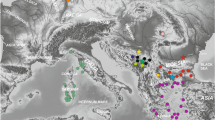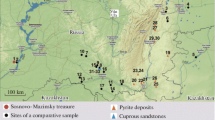Abstract
Lead isotope abundance ratios have become a reliable and common tool for obtaining information on the provenance of archaeological material containing lead. This paper presents Pb-isotope data of lead-silver smelting relics dating to the High Middle Ages, data from Roman objects, as well as data from objects of various other periods from Wiesloch and the surrounding area. The results are compared to Pb-isotope data from the Wiesloch Pb-Zn deposit and some Rhenish lead deposits. Results indicate that during the Roman period, only local lead was used at Wiesloch, while during later periods, lead from other sources is also present.


Similar content being viewed by others
References
Bachmann H-G (1977) Bleiglättefund aus der Nordeifel. Bonner Jahrbücher 177:617–622
Bartels C (2000) Sauerländisches Blei für die Mansfelder Hütten. Blei zur Entsilberung des Mansfelder Kupfers. In: Knape R (ed) Martin Luther und der Bergbau im Mansfelder Land. Lutherstadt Eisleben 105–120
Bissinger K (1888) Funde römischer Münzen im Großherzogtum Baden; Theil 2. Beilage zum Programm des Großherzoglichen Progymnasiums Donaueschingen 18–32 Donaueschingen
Brevart O, Dupre B, Allegre CJ (1981) Metallogenesis at spreading centers; lead isotope systematics for sulfides, manganese-rich crust, basalt and sediments from the Cyamex and Alvin areas (East Pacific Rise). Econ Geol 76:1205–1210
Durali-Müller S, Brey GP, Wigg-Wolf D, Lahaye Y (2007) Roman lead mining in Germany: its origin and development through time deduced from lead isotope provenance studies. J Archaeol Sci 34:1555–1567
Fröhlich M, Steuer H (2000) Burgen und Bergbau – zu neuen Ausgrabungen an der “Birchiburg” in Bollschweil – St. Ulrich, Kreis Breisgau-Hochschwarzwald. Archäologische Ausgrabungen in Baden-Württemberg 1999:233–237
Gottschalk R, Baumann A (2001) Material provenance of late-Roman lead coffins in the Rheinland, Germany. Eur J Mineral 13:197–205
Hildebrandt LH (1989) Ein römischer Straßenvicus bei der Dornmühle westlich von Wiesloch. Kraichgau 11:83–93
Hildebrandt LH (1997) Schwermetallbelastungen durch den historischen Bergbau im Raum Wiesloch. Handbuch Boden 7:1–191, Karlsruhe (LfU)
Hildebrandt LH (1998) Schwermetallbelastungen durch den historischen Bergbau im Raum Wiesloch. Dissertation Ruprecht-Karls-Universität, Heidelberg. 375pp
Hildebrandt LH (2004) 2000 Jahre Blei-Zink-Silber-Bergbau in Wiesloch bei Heidelberg – Eine Übersicht. Z Gesch Berg- und Hüttenwesens 10:4–26
Hörter F (2011) Das Bergwerk Silbersand im Nettetal. Mayener Beiträge zur Heimatgeschichte 14:43–54
Knauf N (2006) In der Landschaft des niederen Deutschlands, welche Eifel genannt wird. Der Aufschluss 57(2):71–90
Mone F (1859) Römisches Bergwerk zu Wiesloch. Zeitschr Gesch Oberrheins 10:389
Pfaff K, Hildebrandt LH, Leach DL, Jacob DE, Markl G (2010) Formation of the Wiesloch Mississippi Valley-type Zn-Pb-Ag deposit in the extentional setting of the upper Rhinegraben, SW Germany. Miner Deposita 45:647–666
Ströbele F, Wenzel T, Kronz A, Hildebrandt LH, Markl G (2010) Mineralogical and geochemical characterization of high-medieval lead-silver smelting slags from Wiesloch near Heidelberg (Germany)—an approach to process reconstruction. Archaeol Anthropol Sci 2:191–215
Ströbele F, Staude S, Pfaff K, Premo WR, Hildebrandt LH, Baumann A, Pernicka E, Markl E (2012) Pb isotopic constraints on fluid flow and mineralization processes in SW Germany. Neues Jb Mineral Abh 189(3):287–309
Zwicker U, Gale N, Stos-Gale Z (1991) Metallographische, analytische und technologische Untersuchungen sowie Messungen der Bleiisotope an Otto-Adelheid Pfennigen und Vergleichsmünzen meist aus dem 9.-11. Jahrhundert. Commentationes de Nummis Saeculorum IX-XI in Suecia repertis 7:59–146
Acknowledgments
We are grateful to Andreas Hauptmann (Deutsches Bergbaumuseum, Bochum) and the Mineralogisches Institut der Universität Münster for sample material. We would also like to acknowledge the Stadtmuseum Leimen for permission to sample a lead bullion from the tenth century. Our sincere thanks go to Michael Brauns, who conducted the lead isotope analysis at the Curt-Engelhorn-Zentrum für Archäometrie, Mannheim. Friedrich Begemann, Wolfgang Siebel, Thomas Wenzel, Udo Neumann and Michael Matzke are thanked for their helpful discussions. This study was funded by the Promotionsverbund “Römischer bis neuzeitlicher Bergbau in Wiesloch (Baden) aus lagerstättenkundlicher, historischer und archäologischer Sicht”, Universität Tübingen, and the Alfried-Krupp-Förderpreis für junge Hochschullehrer to Gregor Markl.
Author information
Authors and Affiliations
Corresponding author
Rights and permissions
About this article
Cite this article
Ströbele, F., Hildebrandt, L.H., Baumann, A. et al. Pb isotope data of Roman and medieval objects from Wiesloch near Heidelberg, Germany. Archaeol Anthropol Sci 7, 465–472 (2015). https://doi.org/10.1007/s12520-014-0208-1
Received:
Accepted:
Published:
Issue Date:
DOI: https://doi.org/10.1007/s12520-014-0208-1




